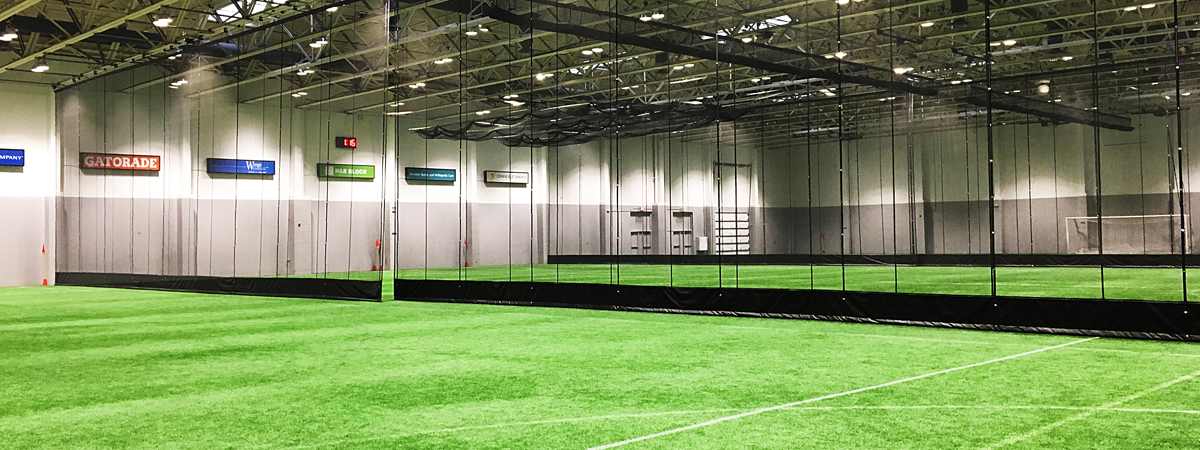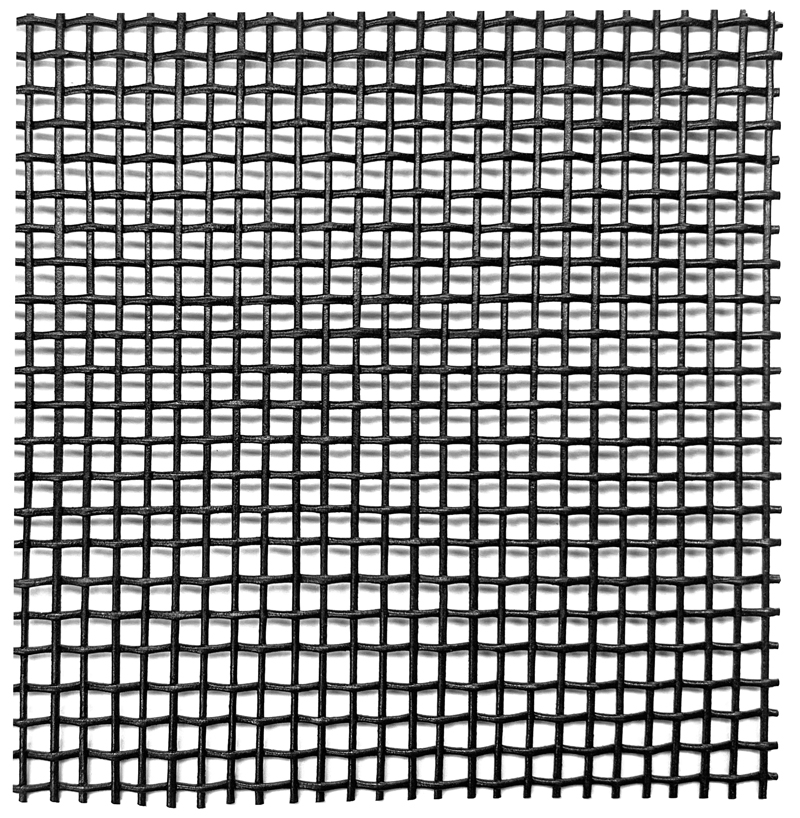Common Materials Used For Gym Divider Curtains; Reviewing Your Options

IN THIS ARTICLE
Sorting Through Your Options To Choose the Best Gym Divider Material
If you’ve been looking at divider curtains or nets for your gym, you’ll know you have multiple options regarding which fabric will be best for your situation. Which is best for your situation will be determined by many factors. These factors include; what your facility will be used for, how often it will be used, how long you expect the gym divider to last, who will be handling your maintenance, your budget, and how you want your facility to look.
To help you decide which material will be best for your situation, we’ve compiled information on some of the most popular material options for gym dividers; standard mesh, Flex-Mesh, netting, Vinyl, a combination of Vinyl and standard mesh or Vinyl and Flex-Mesh, and a combination of Vinyl and netting. We’ll list some of the facts about each type and discuss the pros and cons of each type of material. Finally, we’ll give some pro tips that may help you learn about what material could be a good choice in several common specific situations.
First, let’s take a look at the most popular material options.
Combination Vinyl/Mesh Gym Dividers
A combination of Vinyl and mesh is a popular choice of materials for all sorts of gym dividers. On a fold-up curtain or a walk draw curtain, you can combine any height of standard vinyl with either Flex-Mesh or standard mesh. How much standard vinyl you choose will depend on your need to see through the curtain. If you need a lot of visibility, a Flex-Mesh curtain with a smaller Vinyl base of 1’, 2’, or 3’ is recommended. If you desire more privacy but still require light and airflow, then an 8’ Vinyl base with Standard Mesh on top is common.
A few other facts to consider when looking at Vinyl/Mesh combination curtains:
Vinyl is a very durable material. It comes in a wide variety of colors. Flex-mesh is available in a variety of colors, but white, gray, and black are the most common. You can print logos and graphics on standard Vinyl. (We require artwork files in .eps or .ai format before order approval when printing on Vinyl. Not all colors show up on all colors of vinyl). You cannot print on Flex-Mesh. You can add a pocket to the bottom of a Vinyl curtain to add a chain weight to the bottom on walk-draw curtains. This will help keep the curtain in place during use to keep balls from rolling under it. If it’s a motorized curtain, you will need some weight at the bottom to act as a counterweight to lift the curtain.
- You could use a combination of Vinyl and Standard Mesh or a combination of Vinyl and Flex-Mesh
- Need visibility? Then a 1′, 2′, or 3′ Vinyl base with the remainder being Flex Mesh is ideal.
- Need privacy? Then an 8′ Vinyl base and the rest being Standard Mesh will work well.
Combination Vinyl/Netting Gym Dividers
We get a lot of requests for combination netting and Vinyl gym divider curtains. However, we DON’T RECOMMEND this combination. Curtains made from a combination of netting and Vinyl will stretch and scallop at the bottom. (The netting stretches and Vinyl will scallop where the grommets are attached, and the result isn’t pretty.) If you want gym dividers made from netting, they should be all netting. The only exception to this would be adding a small (4″ – 6″ Vinyl pocket at the bottom of the netting for a chain weight.)
Standard Mesh
Standard mesh has almost the exact specifications as Flex-mesh; it’s just not as easy to see through. You’ll be happy to know it is usually much less expensive. So if you don’t require as high a level of visibility as offered by Flex-mesh but still want a durable, strong material that will hold its shape well over time, Standard mesh may be for you.
- Lets some light through, but not as easy to see through as Flex-Mesh material
- A strong, durable material. It holds its shape well over time
- It comes in stock colors white, grey, black, red, blue, and green. Other colors are typically available upon request.
- Can be used in combination with netting or Vinyl
Flex-Mesh

If you need a high level of visibility from your divider curtain, then Flex-mesh is a great option. Spectators, trainers, and supervisors can easily see through Flex-mesh. It is a versatile material that can be combined with Vinyl or netting. It holds its shape well and can accommodate cutouts for things like doorways and pass-through windows. However, Flex-mesh would NOT be a good choice as a backstop for golf, baseball or lacrosse as it would wear quickly. It would be a good choice as a backstop for sports like volleyball, soccer, or basketball.
- Flex-mesh lets light through
- Good visibility – easy for spectators, trainers, and supervisors to see through
- Strong, durable material
- Holds its shape well over time
- A versatile material that can accommodate cutout doorways
- Available in white, grey, and black
- Can be used in combination with netting and Vinyl.
Netting
Netting is a good option for curtains if you need a lighter-weight divider and/or if you desire visibility. Various netting materials can be used, including Knotted Nylon, Knotless Nylon, and HTTP. If you decide to use netting for your gym divider, then a tension net system is possible. A tension net system is not an option when using mesh or Vinyl.
Tension Gym Divider Nets allow you to divide your facility easily, requiring no permanent structures. They are easy to install and easy to put up and take down. See a Tension Gym Divider Net in action here.
A disadvantage of netting is that it will stretch out of shape over time.
- A wide variety of netting materials can be used, including Knotted Nylon, Knotless Nylon and HTTP.
- A gym divider made from netting will be lighter weight than one made of Vinyl or mesh.
- Netting will let light through and will allow spectators, trainers, and supervisors to see through it.
- A tension net system is an option (whereas it is not an option with mesh or vinyl curtains) See a Tension Gym Divider Net in action here.
- Flame retardant nets are available when needed.
- Disadvantage: Nets will stretch out of shape over time
Vinyl
Vinyl is a very durable material that is resistant to tearing and stretching. If you desire privacy when sectioning off the spaces in your facility so participants are not distracted by what is happening in the space next to them, Vinyl may be an option. Vinyl is available in various colors and logos, and graphics can be added for branding. (We require artwork files in .eps or .ai format before order approval when printing on Vinyl. Not all colors show up on all colors of vinyl). You can add a pocket to the bottom of a Vinyl curtain to add a chain weight. This helps keep the curtain in place during use to keep balls from rolling under it on a walk-draw curtain. On a motorized curtain it you need the added weight at the bottom to act as a counterweight so the curtain can be lifted properly. Vinyl can also be used in combination with Standard and Flex-Mesh.
A disadvantage of Vinyl is that it is a heavier material, so if you use it for a walk-draw curtain you will have more weight to move. Another potential disadvantage of a Vinyl Divider Curtain is that you can not see through it. So, if you need to see through your divider curtain, don’t use Vinyl.
- Durable material resistant to tearing and stretching
- You can add weight to it at the bottom
- You can’t see through it
- Available in multiple colors
- You can add logos or graphics for branding; we would need to see the artwork to determine if your logo would work on the color of vinyl you are choosing to use. Some logos don’t show up well on certain colors of vinyl for some reason.
- Vinyl can be used in combination with Flex-Mesh or Standard Mesh
- A disadvantage of Vinyl is that it is a heavier material, so if you use it for a walk-draw curtain, you will have more weight to move.
Pro-Tips
- For a divider curtain that is going to be a combination of netting and standard vinyl, or mesh and standard vinyl; 8′ of standard vinyl on the lower portion typically works out to be the most cost-effective solution. (This is of course only an option if you don’t need to see through the curtain.)
- If you are considering Flex-mesh, please know it is not a good choice as a backstop for baseball, golf, or lacrosse as it would wear quickly, but it would hold up much better for sports like volleyball, soccer, or basketball.
- On any motorized system, netting will cost more than even Flex-mesh.
- On non-motorized systems, (Tension, Walk-draw, and stationary), netting is the cheapest option for gym dividers.
- Standard Mesh can be used for border protection to stop the occasional ball. We would not use it for a backstop that was continually taking consistent balls hit into it for sports like baseball, softball, or lacrosse. We would recommend netting for these situations.
Finding the perfect gym divider material can be daunting. There are many factors to consider such as usage, longevity, maintenance, budget, and aesthetic appeal. To help you make an informed decision, we have put together information on some of the most popular materials used for gym dividers. These include standard mesh, Flex-Mesh, netting, Vinyl, and various combinations of these materials. We discussed the pros and cons of each material and provided pro tips for specific situations. If you need a high level of visibility, Flex-Mesh is an ideal option, as it allows light to pass through. It’s also versatile enough to be combined with Vinyl or netting. On the other hand, standard mesh is an affordable alternative that remains durable over time. Netting is perfect for a lighter-weight divider and/or if you desire visibility, while Vinyl is a sturdy material that comes in a wide variety of colors and can be printed with logos and graphics. By analyzing all of these options, you can choose the best gym divider material for your specific needs.
Are you considering adding Gym Dividers to your gym, indoor training facility, auditorium, or another indoor facility? Contact us to explore your options, ask questions or request a quote.
FAQ’s
A divider curtain suspended from a steel track mounted to the ceiling or suspended from a cable. One person can and push or pull the curtain into place.
When you use netting as a divider curtain for a gym or other indoor sports facility, a disadvantage is that the netting will stretch and lose it’s shape over time.

